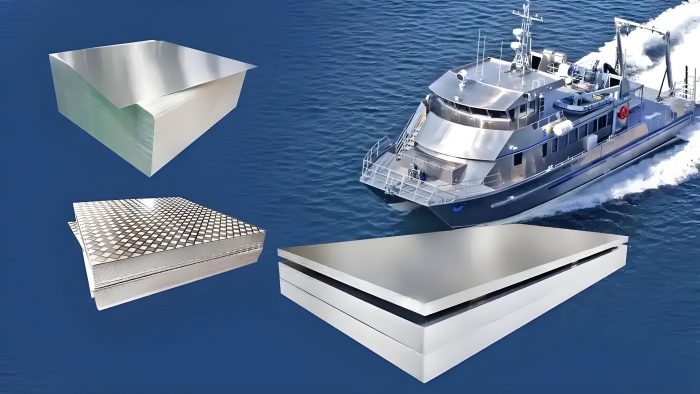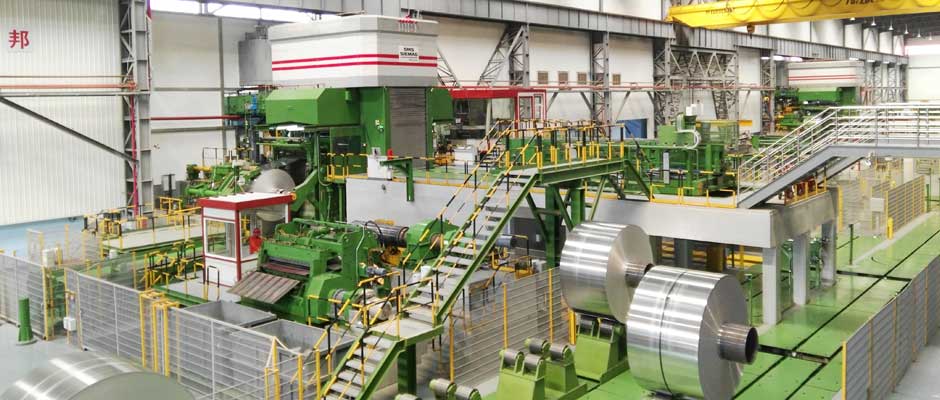In marine applications, aluminum alloys have become one of the key materials due to their light weight, high strength, corrosion resistance and good machinability. The lightweight characteristics of aluminum alloys can improve the load-bearing capacity and fuel efficiency of ships, and are suitable for various types of ships, including commercial ships, yachts, warships, etc. Aluminum alloys for marine applications mainly include 5000 series and 6000 series. These aluminum alloys are favored for their light weight, high strength and excellent corrosion resistance, and are suitable for use in marine environments.

5000 series aluminum alloys use magnesium as the main alloying element (usually 3%-5%), have high corrosion resistance, good welding performance and lightweight advantages, and are the most commonly used aluminum alloy types in shipbuilding. The following are the characteristics and applications of typical grades:
- 5052 aluminum alloy
Chemical composition: Al ≈97.2%, Mg ≈2.5%, a small amount of Cr/Mn.
Performance:
Corrosion resistance: Excellent, especially in marine and humid environments.
Strength: Medium strength (tensile strength of about 240-300 MPa), but the strength can be improved after cold working.
Weldability: Good, suitable for TIG/MIG welding.
Application:
Ship tanks, oil pipes, deck structures.
Aircraft shells, automobile body panels, building decoration materials.
- 5083 aluminum alloy
Chemical composition: Mg 4.0-4.9%, Mn 0.4-1.0%, Zn ≤0.25%.
Performance:
Strength: High (tensile strength ≥305 MPa), suitable for high-load structures.
Corrosion resistance: Excellent, especially for seawater and chloride environments.
Weldability: Excellent, weld strength is close to the parent material.
Application:
Shipbuilding: hull, deck, bulkhead, tanker.
Marine engineering: offshore platforms, buoys, underwater equipment.
Low temperature scene: still maintain toughness below -196℃ (such as LNG storage tanks).
- 5086 aluminum alloy
Chemical composition: Mg 4.0-4.9%, Mn 0.4-1.0%.
Performance:
Strength: slightly lower than 5083, but better ductility and corrosion resistance.
Weldability: excellent, suitable for complex welded structures.
Low-temperature performance: still maintains toughness at low temperatures.
Application:
Shipbuilding: gangways, coamings, refrigerated equipment.
Chemical industry: pressure vessels, piping systems.
- 5059 aluminum alloy
Chemical composition: Mg 3.1-3.9%, Mn 0.5-1.0%.
Performance:
Corrosion resistance: better than 5083, stable in seawater and acidic environments.
Strength: medium (tensile strength ≈ 290-330 MPa).
Processability: suitable for cold processing such as stamping and bending.
Application:
Shipbuilding: hull structural parts, deck supports.
Cryogenic storage tanks: liquefied natural gas (LNG) storage tanks.
Transportation: lightweight automotive parts (such as body panels).
- 5383 aluminum alloy
Chemical composition: Mg 3.5-4.5%, Mn 0.8-1.5%, Zn 0.1-0.3%.
Performance:
Strength: Strength can be significantly improved by microstructure regulation (such as grain refinement).
Corrosion resistance: Excellent performance after optimizing grain boundary structure.
Weldability: Heat input needs to be controlled to avoid cracks.
Application:
Shipbuilding: high-strength hull structural parts.
Aerospace: non-critical load-bearing parts.
Military field: armored vehicle shell.
- 6000 series aluminum alloy (Al-Mg-Si series)
6000 series aluminum alloy uses magnesium and silicon as the main alloying elements, and is strengthened by heat treatment (T6). It has medium strength, good processability and weldability, but its corrosion resistance is slightly inferior to 5 series.
Typical grades:
6061: Medium strength (T6 tensile strength ≥310MPa), used for marine brackets and piping systems.
6082: High strength (T6 tensile strength ≥ 310 MPa), used for hull frames and deck supports.
Performance:
Strength: T6 tensile strength ≥ 310 MPa.
Processability: Suitable for extrusion molding of complex structures.
Corrosion resistance: Generally, surface treatment (such as anodizing) is required for enhancement.
Heat treatment strengthening: Improve strength through T6 state (solid solution treatment + aging).
Application:
Shipbuilding: brackets, piping systems, refrigeration device frames.
Industrial fields: building profiles, rail transit components.
Key performance requirements of marine grade aluminum sheet:
– Corrosion resistance:
Aluminum alloys are prone to form dense oxide films (Al₂O₃) in seawater, but galvanic corrosion (such as contact with stainless steel) must be avoided. 5000 series and 6000 series aluminum alloys have the best corrosion resistance due to their moderate magnesium content.
– Surface treatment:
Anodizing and spraying anti-corrosion coatings (such as epoxy resin) can further improve corrosion resistance.
– Welding performance:
5000 series and 6000 series aluminum alloys have good weldability and are suitable for TIG/MIG welding.
– Lightweight and strength:
The density of aluminum alloy is about 2.7g/cm³ (1/3 of steel), which can reduce the weight of the hull by 15%-20% and improve fuel efficiency.
Alloys such as 5083 and 5086 provide sufficient structural strength while maintaining lightweight.
– Low temperature performance:
Aluminum alloys still maintain toughness at low temperatures (-196℃), which is suitable for low temperature scenes such as liquefied natural gas (LNG) storage tanks.
Advantages of aluminum alloys in marine applications:
– Weight reduction and energy saving:
The use of aluminum alloy hulls can reduce weight by 15%-20%, reduce fuel consumption, and increase speed (up to 50 knots).
Compared with fiberglass reinforced plastic (FRP) hulls, aluminum alloy ships are lighter, stronger, and have higher space utilization.
– Corrosion resistance and long life:
In marine environments, the annual corrosion rate of alloys such as 5083 and 5086 is less than 0.4μm, and the life span can reach more than 20 years.
The hull is further protected by sacrificial anodes (such as Al-Zn-In-Sn alloy).
– Environmental protection and recycling:
Aluminum alloys can be 100% recycled, reducing resource waste.
Compared with fiberglass hulls, aluminum alloys are non-toxic and non-polluting, meeting environmental protection requirements.
In marine applications, 5000 series aluminum alloys (such as 5083, 5086, 5059) have become the preferred materials due to their high corrosion resistance, light weight and excellent welding performance, especially suitable for marine environments and low temperature scenarios.
Contact Us
- 1103, No.14 Waihuan Road, CBD,Zhengzhou, China
- +86-0371-65621391
- nydia@aluminumhm.com
- Contact Form

